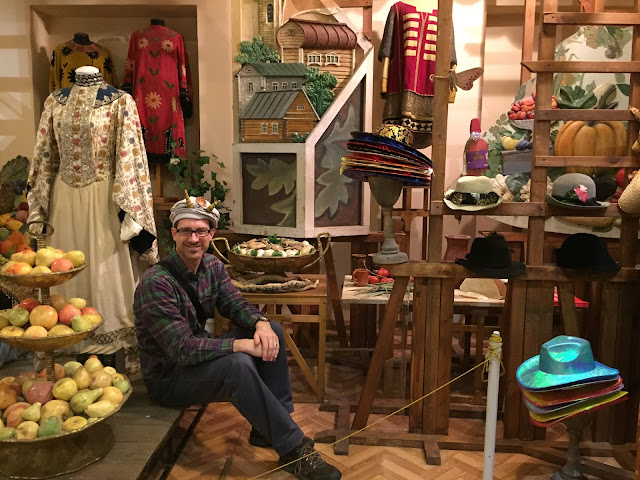156. St. Petersburg State Museum of Theater and Music
The St. Petersburg State Museum of Theater and Music sits next door to the Alexandrinksy Theater at the southeast corner of Ostrovsky Square. The exhibits inside cover the history of opera, ballet, and the dramatic arts in St. Petersburg since the early 18th century, with an emphasis on the 19th and early 20th centuries. Costumes, set designs and props, playbills and other artwork, and videos tell the stories of the theaters and artists that have made the performing arts scene in St. Petersburg so rich over the centuries (this is the cultural capital of Russia, after all).
The museum is moderate in size and scope, and could be seen in about an hour if you only visit the main exhibition hall. However, I spent approximately two hours there because I visited all the areas in the museum, each one with a separate ticket:
1) A special exhibit about the poet, playwright, and actor Vladimir Mayakovsky. He was a snappy dresser, and I enjoyed the collection of outfits on display. My favorite part here was the photographs of life around town in the first two decades of the twentieth century.
2) A behind-the-scenes (literally - the exhibit was behind a stage) look at scenery, props, costumes, and mechanical sound effects contraptions. This was followed by a room that had models of various historical European theaters.
3) The permanent exhibition, which included photographs, posters, objects, and a few interactive displays that reviewed the history of performing arts in St. Petersburg, with a particular emphasis on the culture of opera and ballet culture.
One of the museum staff members "adopted" me and gave me a private tour for a couple hours. I don't think that is standard practice (no other visitors received a private tour while I was there), so perhaps she just thought it would be a fun diversion that day with a rare English-speaking tourist. I appeared to be the only visitor who bought tickets for every exhibit, so maybe she was excited that I was interested in everything there. She did not speak any English but was patient in her Russian explanations of the exhibits and I believe I understood most of what she told me. She was really excited about taking pictures of me (with my own cell phone). She prompted me to try on several of the hats in the museum costume exhibit, as well as pose in different ballet positions when we reached the room that discussed the life and art of St. Petersburg's most famous ballerina from a century ago, Anna Pavlova. The Vaganova Academy of Russian Ballet is literally next door to the museum, and if they had any talent scouts in the building, perhaps they'll call me soon!
The museum is moderate in size and scope, and could be seen in about an hour if you only visit the main exhibition hall. However, I spent approximately two hours there because I visited all the areas in the museum, each one with a separate ticket:
1) A special exhibit about the poet, playwright, and actor Vladimir Mayakovsky. He was a snappy dresser, and I enjoyed the collection of outfits on display. My favorite part here was the photographs of life around town in the first two decades of the twentieth century.
2) A behind-the-scenes (literally - the exhibit was behind a stage) look at scenery, props, costumes, and mechanical sound effects contraptions. This was followed by a room that had models of various historical European theaters.
3) The permanent exhibition, which included photographs, posters, objects, and a few interactive displays that reviewed the history of performing arts in St. Petersburg, with a particular emphasis on the culture of opera and ballet culture.
One of the museum staff members "adopted" me and gave me a private tour for a couple hours. I don't think that is standard practice (no other visitors received a private tour while I was there), so perhaps she just thought it would be a fun diversion that day with a rare English-speaking tourist. I appeared to be the only visitor who bought tickets for every exhibit, so maybe she was excited that I was interested in everything there. She did not speak any English but was patient in her Russian explanations of the exhibits and I believe I understood most of what she told me. She was really excited about taking pictures of me (with my own cell phone). She prompted me to try on several of the hats in the museum costume exhibit, as well as pose in different ballet positions when we reached the room that discussed the life and art of St. Petersburg's most famous ballerina from a century ago, Anna Pavlova. The Vaganova Academy of Russian Ballet is literally next door to the museum, and if they had any talent scouts in the building, perhaps they'll call me soon!





























































Comments
Post a Comment